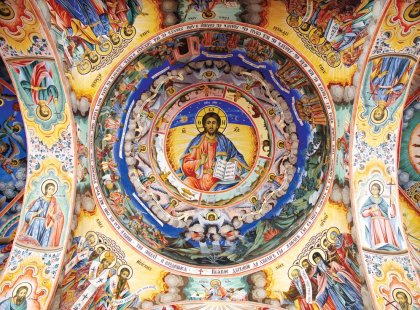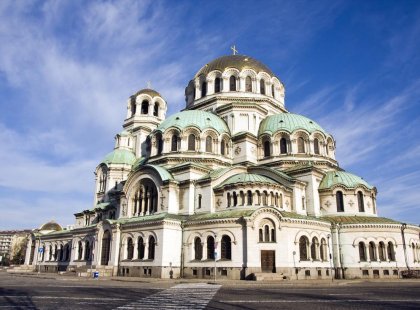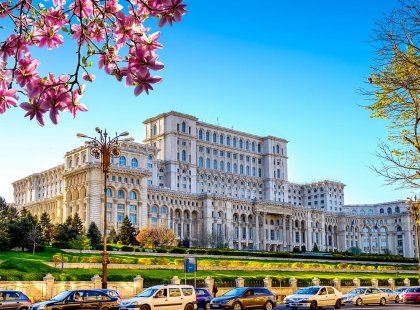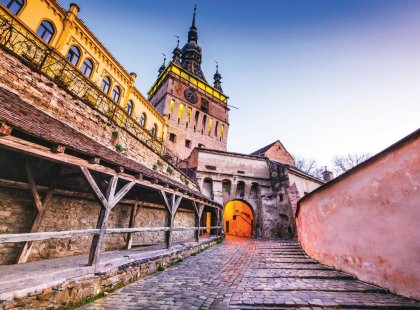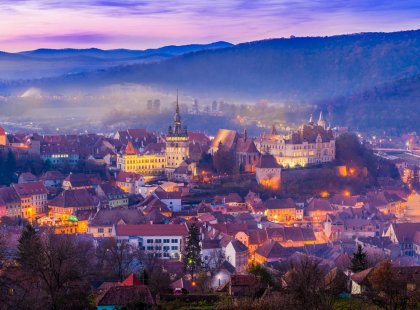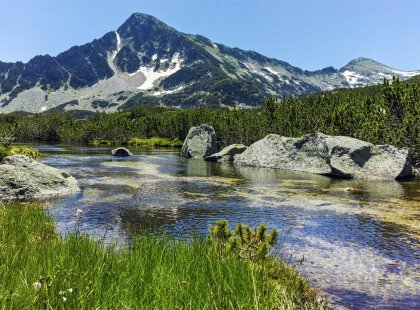Eastern Europe Explorer
18 days
From
$ 3360
Duration18 days
Tour from bustling Budapest to Bulgaria’s ancient capital, Sofia. Be mesmerised by the magic of Hungary, Romania and Bulgaria on this explorer tour through the best and most beautiful regions of Eastern Europe. Explore the captivating cities of Budapest, Bucharest and Sofia. Sample culinary delights with local folk in Viscri, be inspired by the traditional craft workshops in Plovdiv, hear enthralling myths from Transylvania and visit the quaint town of Bansko, snug at the foot of the Pirin Mountains. This is a journey full of culture and history, of monuments, markets and museums, tantalising towns and charming cities.
-
Duration: 18 daysService level: Standard
-
Physical Grading: Light
-
Ends in: SofiaAges: 15+
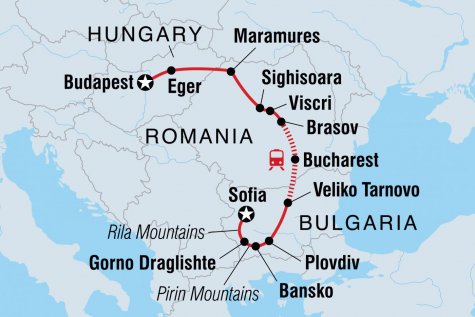
Itinerary
Day 1: Budapest
Szia! Welcome to Hungary. Since the collapse of communism, Budapest has experienced something of a renaissance. The grand architecture and boulevards evoke a time gone by, while glamorous stores and restaurants make this one of the truly great cities of Europe. After the welcome meeting, you might like to head out to explore the city by night. Perhaps visit the Jewish Quarter for dinner and explore the many options for a nightcap.
Day 2: Budapest
Today enjoy a free day to explore Budapest. Hiring a bike is a great way to move between the sights. Perhaps head to Statue Park to see the communist monuments that were removed from the city after the fall of the Iron Curtain. One unmissable activity is a soak in Budapest's hot thermal baths. There are several around the city, ranging from elegant to simple outdoor types. The pools vary in temperature, and some even feature whirlpools or seats where you can play chess while you turn into a prune. You can wander the pedestrianised streets of the old district of Buda with the castle on the hill and the Matthias Church, then perhaps take a cruise along the Danube, discovering the history that unfolded along the riverbanks. Tonight perhaps discover some of the city’s ‘ruin bars’, cool places to grab a drink that are usually located in abandoned buildings in downtown Pest and are filled with thrift-shop décor and mismatched art.
Meals: B
Day 3: Eger
Take a two-hour train east to Eger today. This beautifully preserved Baroque town is surrounded by hills and is home to some of the most renowned vineyards in Eastern Europe. Visit the wine cellars of the seductively-named Valley of the Beautiful Women with the group to sample some of the town's famous 'Bull's Blood' red wine, which supposedly gave the Hungarian army supernatural strength during their battle against the Ottoman Empire. Among the Turkish soldiers it was rumoured that the enemy army drank blood diluted with wine, as the firm resistance they encountered couldn't be explained any other way. In your own time, perhaps explore Eger's 13th-century castle, which was the scene of the historic siege that thwarted the Ottoman Empire's advancement into Western Europe. Here you can explore the Gothic Palace, a gallery of fine Hungarian art, and tour underground passageways of archaeological finds. You may also like to check out the town's 19th-century cathedral, the northernmost medieval minaret in Europe for views of the city, or the Minorite church in Dobo Square.
Meals: B
Day 4: Debrecen / Maramures
Travel by bus to the pleasant town of Debrecen today (approximately 3 hours). While here, you'll have time to explore Deri Square with its fountains, colourful buildings, museums, and golden Great Church. Continue on by train and private vehicle across the central plains into the Maramures region of Romania. This second part of the journey should take around six hours. Time in Romania is an hour ahead of Hungary, so don't forget to set your watch. Maramures is also a place that can feel like stepping back in time. The region may be modernising, but among the traditional wooden houses and churches, the traditional music and forests, you can still find parts of life fairly unchanged since medieval times. Upon arrival, settle into your room at the pension, which is run by a local family, and look forward to some hearty home-cooked fare.
Meals: B, D
Day 5: Maramures
Today you’ll discover more about the region of Maramures ('mah-ra-moo-resh') and how it seems frozen in time. Rich in tradition and folklore, the music, costumes, festivals and ancient superstitions of one of the last peasant cultures in Europe continue to thrive here. Each village is distinctive in its colourful outfits and style of hat. Maramures is particularly famed for its wooden churches, many of which are World Heritage-listed. Set out on a guided group tour to explore the region. You’ll visit the unique Merry Cemetery in Sapanta, where the life stories of the deceased – the good and the bad of their lives – are displayed on colourful wooden crosses. There are poems and limericks, and little pictures illustrating how the person died, all single-handedly carved over 40 years by Stan Ioan Pătraş until 1977. The work has continued for the last 30 years by his apprentice. You’ll also see the village museum in Sighetu, an assembly of beautiful local wooden architecture, along with stopping by various other traditional villages.
Meals: B, D
Day 6: Sighisoara
Today is a long day of travel (approximately 9 hours) through pastoral fields and untouched Saxon towns to Sighisoara in Transylvania. While the name may conjure up images of haunted castles, gothic churches and vampires, this is only a small part of what makes Transylvania such an enchanting and exciting destination. Medieval Sighisoara is likely to seduce visitors more than any other place in Romania. Another World Heritage site, the town was first settled by the Romans but flourished under the Saxons from the 12th century. Take a walk around the old town, which coils up a narrow hill and is surrounded on all sides by fortified walls, and explore the 64 metre-high clock tower that dominates the citadel. The town is famed as the birthplace of Vlad Dracul III, better known as Vlad the Impaler, whose name was the inspiration for Bram Stoker’s iconic Count Dracula. Vlad III is revered as a folk hero by Romanians for driving off the invading Ottoman Turks, of which his impaled victims are said to have included as many as 100,000. Maybe have traditional Romanian fare at ‘Casa Dracula’ tonight.
Meals: B
Day 7: Viscri
While your next stop is less than an hour away, you'll feel like you've entered a different world. The small Transylvanian village of Viscri was originally inhabited by Saxons from the Luxembourg area, and the whole scene is picture-postcard rural. This idyllic village of red tiled roofs is a World Heritage site, virtually unchanged for 900 years. You’ll visit the town's fortified church (thought to be the oldest in Transylvania). You’ll also learn about the Sock Project, which supports the local Roma community. Time permitting, you may even like to go for a horse cart ride through the area, over pastures and through wondrous woods of oak and hornbeam. In the evening, indulge in a home-cooked dinner prepared by a local family, sampling fresh produce, homemade wines and schnapps. Tonight, stay in rustic houses that the locals rent out to visitors.
Meals: B, D
Day 8: Brasov
Today continue to the 13th-century Saxon city of Brasov (approximately 2 hours). Also known by its German name of Kronstadt, the town is flanked by mountains and city walls was once a major medieval trading centre. Enjoy free time to explore, checking out the ornate churches, townhouses and squares surrounded by gingerbread-roofed merchants' houses. It's worth visiting the town's main attraction, the gothic (Biserica Neagra) Black Church, which took its name from its blackened appearance after a fire in 1689. Stroll along pedestrianized Strada Republicii, take a cable car up to Mt Tampa, or maybe explore the nearby Rasnov Fortress. The fortification is perched on a rocky hilltop above the town of Rasnov, and was constructed by Teutonic Knights in the 13th century as a place of refuge for the common people from Tartar invaders. Otherwise, you could head to Bran Castle, said to be the inspiration for the home of Bram Stoker's Dracula. Though not exactly super spooky, it is undeniably impressive, perched on a high cliff top and surrounded by pine trees. For those looking for a little nightlife action, Brasov has plenty of funky bars and restaurants to enjoy once darkness falls.
Meals: B
Day 9: Bucharest
Head south to Bucharest today (approximately 3 hours). The city is increasingly known for its cosmopolitan vibe and energy, and while not the most beautiful or stylish city, there are some wonderful art nouveau buildings, ancient churches and monasteries, lush parkland, lakes and elegant boulevards. Romania's interesting capital also likes big things. It’s home to one of Europe's biggest squares, and its Palace of Parliament is the second largest building in the world – former dictator Nicolae Ceauşescu ordered the construction of the 12-storied Palace of Parliament, a building of staggering scale and opulence that includes 1,100 rooms and 4,500 chandeliers. You’ll take a guided walking tour around the city to help you get your bearings, then in free time you can choose to further explore some of the sights pointed out. Maybe seek out some traditional home-cooked Romanian food with your fellow travellers.
Meals: B
Day 10: Bucharest
Today is a free day to explore Bucharest. Perhaps visit the grand concert hall of the Romanian Athenaeum, or take a walk around the city's National Museum of Art or the Museum of the Romanian Peasant. Alternatively, why not indulge your inner foodie on a Home Cooked Bucharest Urban Adventure tour. Another great way to see the city is by bicycle, perhaps exploring some of the city’s neighbourhoods for a glimpse into the daily lives of Bucharest’s residents.
Meals: B
Day 11: Veliko Tarnovo
Travel by train across the friendship bridge into Bulgaria and on to the picturesque town of Veliko Tarnovo (approx 6 hrs). Veliko Tarnovo's history is incredible. Founded in 4500 BC by the Neolithic people, the Romans later built the first fortress walls and in the 6th century a Byzantine capital was established on Tsarevets Hill by Emperor Justinian. After the foundation of the second Bulgarian empire in 1185, it became the second most important and beautiful city in the region (after Constantinople) and trade and culture flourished for the next 200 years. In 1393 the town fell to the Turks who held the city until the Russians liberated it in 1877. Because of its importance during the second Bulgarian empire, the city was chosen as the place where the Bulgarian constitution was written in 1879 and where the official proclamation of Bulgaria as an independent state was made in 1908.
Meals: B
Day 12: Veliko Tarnovo
This morning join your leader for a visit to Veliko Tarnovo's imposing Tsarevets Fortress which overlooks the city. This once-magnificent fortress was first built in the 7th century and the ruined citadel is a delight to wander through. The rest of the day is free for you to explore the City of Tsars. Wander through the Old Quarter with its preserved Renaissance houses and handicraft workshops before relaxing in one of the town's cafes or 'vinarnas' (wine bars).
Day 13: Plovdiv
Travel by train from Veliko Tarnovo to Plovdiv (approximately 6.5 hours). Situated on the Maritsa River, Plovdiv was once the meeting point of two ancient transportation routes. Join a local guide for a tour of the main sights and some insight into the town's history. The most remarkable sight is the ancient Roman theatre, accidentally ‘discovered’ after a landslide exposed the site in the early 1970s. Built in the 2nd century BC during the reign of Trajanus, the theatre seats about 6,000 people and is now back in use. From here, wander up to the site of the former hilltop fortress of Nebet Tepe, where you can enjoy excellent views of the city. Head back down to visit the 15th-century Dzhumaya Mosque, still in use today. Later today make sure you indulge in the local cuisine, famed for its grilled meats and vegetables on skewers.
Day 14: Plovdiv
Today is a free day, so why not embark on an aimless wander through Plovdiv's narrow alleyways to see traditional coppersmiths, farriers and potters at work, or browse through the myriads of antique shops lining the streets. Alternatively head out of town and check out the underground crypt at Bachkovo Monastery or discover one of the many hot springs in the Plovdiv region. One of the most well-known spa towns is Hisarya, famous for its 22 mineral springs. Your leader will be on hand to help you organise transportation to get there.
Meals: B
Day 15: Bansko
Journey on to the small town of Bansko (approximately 3 hours). Set at the base of the majestic Pirin Mountains, Bansko is home to more than 150 cultural monuments. Down its cobbled streets, many of its stone houses have been transformed into charming ‘mehanes’ (taverns). Wander through pl. Vazrazhdane and check out the frescoes of the Church of Sveta Troitsa, or the paintings in the Rilski Convent. In the afternoon head out to the Belitsa Bear Sanctuary, home to rescued dancing bears. The sanctuary is the largest of its type in Europe, covering over 120,000 square metres. Here the bears can languish in lush green woods, with a river and pool in each enclosure. Seeing them sleeping in the sun, playing in the water and being free from captivity can be very moving. In the evening, you'll have the opportunity to indulge in some local cuisine. Try filet elena (spicy cured meat) or kapama (simmered meat, rice and sauerkraut), washing it down with some delicious melnik (dark red wine).
Meals: B
Day 16: Pirin Mountains / Gorno Draglishte
This morning venture up into the Pirin Mountains. After a short ride on a chairlift stretch your legs with a hike into the eastern slopes of the mountains, with Mt Vihren, the range's highest peak at almost 3,000m, visible to the west. In the afternoon transfer from Bansko to the small village of Gorno Draglishte (approximately 30 minutes) and spend the night at our local friend's house. While the accommodation is simple and not all rooms have an en suite, the atmosphere is warm and welcoming and you'll be treated to a delicious home-cooked dinner. You'll even have the chance to learn about the traditional weaving practices of the area, and maybe join the hosts for a dance.
Meals: B, D
Day 17: Rila / Sofia
Today journey into the Rila Mountains, where you'll visit the impressive Rila Monastery. Tucked away in a valley, this World Heritage-listed site is the largest and holiest of Bulgaria's orthodox monasteries. It was founded in 927 to keep Bulgarian spiritual and social life alive during Turkish rule. The entire monastery complex is a work of art in itself – check out stunning murals, the 14th-century Hrelyo Tower, the five-domed Birth of the Blessed Virgin Church and the original 19th-century monastery kitchen. Then it's on to Sofia. Bulgaria's capital is a cosmopolitan city with wide tree-lined boulevards and pleasant parks. You've got the rest of the day to wander, so maybe begin with a browse around the cured meats and cheese of the Central Market Hall, then take a walk through the city and see the gold-domed Alexander Nevski Church. You might want to sate your cultural curiosity at the National History Museum, discover artefacts from the many empires of old that have occupied the city at the National Archaeological Museum, or get cultural at the National Art Gallery. In the evening why not meet for a last dinner with your group.
Meals: B
Day 18: Sofia
All good things come to an end, and this morning your adventure officially comes to a close. If you would like to extend your stay in Sofia we are able to book additional accommodation for you (subject to availability).
End place: Sofia
Meals: B
Inclusions
Included
- Eger Wine Tasting
- Maramures Tour with Local Guide
- Sapanta Merry Cemetery
- Barsana Monastery
- Viscri Fortified Church
- Bucharest Guided Walking Tour
- Tsarevets Fortress
- Plovdiv Guided Tour
- Belitsa Bear Sanctuary
- Pirin Mountains Hike & Chairlift
- Rila Monastery Visit
-
Transport
Train, Public bus, Private vehicle, Metro, Tram, Taxi -
Accommodation
Hotel (12 nights), Pension (3 nights), Homestay (2 nights)

